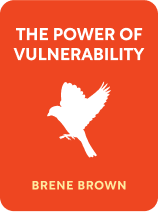

This article is an excerpt from the Shortform book guide to "The Power Of Vulnerability" by Brené Brown. Shortform has the world's best summaries and analyses of books you should be reading.
Like this article? Sign up for a free trial here .
Looking for the key parts of Brené Brown’s The Power of Vulnerability TED Talk? What can you learn from Brené Brown about vulnerability, shame, and wholehearted living?
In Brené Brown’s The Power of Vulnerability TED Talk, she discusses the fact that people today are more lonely, more obese, and more addicted than ever before. In her TED Talk, Brown breaks down the various aspects of shame, addresses the importance of vulnerability, and teaches how to live wholeheartedly.
Continue reading for an overview of The Power of Vulnerability.
The Power of Vulnerability
Many of us don’t want to discuss shame or vulnerability. To deal with our problems, we want positive, straightforward “how-to” explanations that allow us to avoid vulnerability and that offer happiness, beauty, or joy. However, “how-to” explanations don’t work because they don’t address the causes of negative emotions.
In fact, today, people are lonelier, more obese, and more addicted than ever before because they opt to distract or numb themselves rather than address their insecurities or shame. For example, rather than dealing with the cause of their depression, many develop addictions to prescription drugs to “escape” their emotional trauma. Brené Brown goes over all of these topics in her The Power of Vulnerability TED Talk.
What Is Scarcity Culture?
Our tendency toward numbing behaviors is the result of scarcity culture. Scarcity culture operates under the belief that we’re never “enough.” For example, when things go wrong, we often tell ourselves we’re not wealthy enough, strong enough, or happy enough.
This fear drives modern culture, infecting everything from political campaigns to the college admission process. For example, political candidates often offer dystopian views of the future under their opponent, stoking the fears of their base. Similarly, high school counselors often offer dystopian views of the future if students don’t get into the “best” college, stoking the fears of teenagers and their parents.
Wholehearted Living
Scarcity culture can be subverted by wholehearted living. You can achieve wholehearted living by embracing vulnerability and accepting that you are worthy of love and belonging. Most people aren’t raised in a wholehearted way, leaving most to work toward the lifestyle on their own.
Because shame and scarcity culture have many ways of developing, wholehearted living requires constant reflection and self-care. Knowing yourself gives you insight, but actively taking care of yourself builds your self-worth. There are three aspects to wholehearted living: love, belonging, and vulnerability.
Love
Love is a deep connection that operates on respect, affection, and kindness. It isn’t something that you can simply offer or receive, but requires cultivation and growth over time. You can only love someone else as much as you love yourself. If you don’t believe that you’re loveable, you will put up walls that will prevent others from developing sincere relationships with you.
Belonging
Belonging is our intrinsic desire to be a part of something larger than ourselves. Often, we try to change our behavior to fit in based on other people’s expectations. However, this behavior is unfulfilling and creates more barriers to true belonging. True belonging requires that you share your authentic self with the world to connect with other people, linking your sense of belonging to self-acceptance.
Vulnerability
Vulnerability is the willingness to show up and share your authentic self while knowing that you have no control over the outcome of your interactions. Vulnerability removes defensiveness, promotes empathy, and bolsters creativity. Many associate vulnerability with weakness and push people away out of fear of rejection or ridicule. However, you can’t experience wholeheartedness without it.
Shame and Empathy
Shame is insecurity that attaches to self-identity and gets in the way of action or vulnerability. It causes people to believe that they’re unworthy or unloveable. For example, if you feel shame about the way you look, and someone rejects you romantically, you may believe that you’re not “attractive enough,” diminishing your self-worth in the process.
Shame relies on people believing that their experience with insecurity is unrelatable, creating a sense of loneliness. Though shame feels isolating, everyone experiences it (with the exception of severe psychopaths). While no one wants to share their insecurities, talking about shame is the only way to diminish its power because, once you know that you’re not alone, shame loses its leverage.
Common Sources of Shame
Shame often develops in childhood and lingers throughout adulthood. The roots of shame are often built at home or at school and are frequently a result of interactions with authority figures such as teachers or parents. For example, if a teacher calls a student “stupid” in front of the class for forgetting to put their name on their paper, that student may develop shame around their intelligence.
In addition to teachers and parents, negative interactions with siblings often cause shame. Siblings know each other’s triggers and often abuse that knowledge through name-calling, physical abuse, and other cruel practices. These may occur during fights and are usually outlets for unrelated anger.
Shame Triggers
Shame triggers are topics that evoke emotional responses based on your insecurities. These triggers are often developed in childhood but carry on into adulthood. For example, if you were raised to believe that laziness is unacceptable, you may view taking breaks or getting sick as unacceptable because they keep you from working. This may cause you to make unhealthy decisions and overwork yourself to avoid your shame.
Handling Shame
Unfortunately, shame is a part of life. There isn’t a way to eradicate it, but you can deal with it healthily:
First, understand that self-worth has no prerequisites. You don’t have to do anything to be “worthy” of love and belonging. If you feel you have to prove yourself, you’re allowing your shame to dictate your behavior.
Second, when bad things happen, don’t allow them to dictate your self-worth. Don’t allow your guilt or humiliation to turn into shame. Instead of saying, “I’m a bad person,” tell yourself, “I made a bad decision, and I’m working to fix it.”
Third, accountability is important, but never at the cost of shaming. This applies to how you treat yourself as well as how you treat others.
Fourth, practice shame resilience. Shame resilience is the ability to recognize and discuss shame. There are four keys to shame resilience:
- You’re willing to call shame, “shame.” Don’t try to bury or brush off your feelings as that will only lead to them coming back stronger due to repression.
- You know what you’re feeling ashamed about and you know what triggered it. For example, you may feel insecure about your intelligence after someone gives you feedback on your work.
- You can separate your reality from other people’s expectations. For example, if you struggle with being perceived as weak, embrace that you can’t realistically live a healthy life while repressing your emotions to appear “strong.”
- You can reach out to people you trust and talk about your shame. These should be people who have earned your trust and who can bear the weight of your story.
Empathy: The Antidote to Shame
Empathy is the ability to see the world as others see it and understand another person’s feelings. Shame can’t grow in an environment of empathy because understanding eradicates insecurity.
Empathy isn’t the default for most people because it can be challenging or uncomfortable. It requires setting your personal perspective or problems aside and meeting someone at their current emotional level. There are two key elements to empathy: perspective-taking and nonjudgmental understanding.
- Perspective-taking: Perspective-taking is the ability to look at a situation from another person’s perspective instead of your own. Everyone has a “lens” through which they experience the world. To be empathetic, separate yourself from your personal “lens” and accept that someone else’s lens is just as important.
- Nonjudgmental understanding: Nonjudgmental understanding requires the setting aside of personal shame to prevent judgmental feelings or actions. To practice nonjudgmental understanding, share your vulnerability, give others your full attention, and be willing to meet people where they are, not where you want them to be.

———End of Preview———
Like what you just read? Read the rest of the world's best book summary and analysis of Brené Brown's "The Power Of Vulnerability" at Shortform .
Here's what you'll find in our full The Power Of Vulnerability summary :
- The 10 practices that you can use to embrace vulnerability and start living a wholehearted life
- Why thinking that you're never "enough" is dangerous
- The most common sources of shame and how to overcome them






